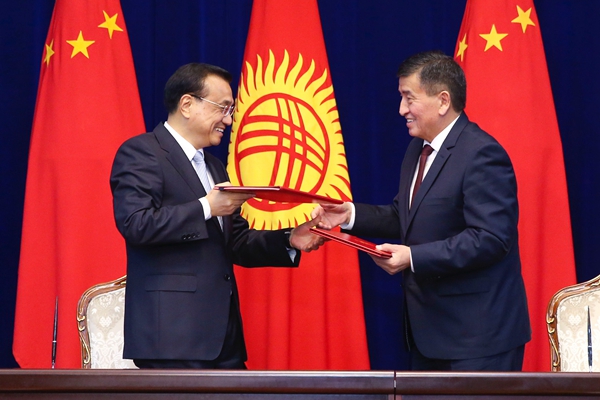Li's trip to secure gains, reinforce bonds
Updated: 2016-11-03 08:34
By Wang Yiwei(China Daily)
|
|||||||||
 |
|
Premier Li Keqiang and Kyrgyz Prime Minister Sooronbay Jeenbekov signed on Nov 2 a joint communiqué between the Chinese and Kyrgyz governments.[Photo/english.gov.cn] |
Premier Li Keqiang embarked on an eight-day trip to Central Asia and Europe on Wednesday, during which he will visit Kyrgyzstan, Kazakhstan, Latvia and Russia. His participation in the 5th Meeting of the Heads of Government of China and Central and Eastern European (CEE) countries in Riga, Latvia, is expected to add fresh momentum to the "16+1" cooperative mechanism and the Belt and Road Initiative (the Silk Road Economic Belt and 21st Century Maritime Silk Road).
The 16+1 mechanism proposed by Beijing is an exchange program involving 1,000 people from China and 16 CEE countries to enhance people-to-people communications.
Since the first 16+1 meeting in Warsaw in 2012 the multinational mechanism has become an example of China-Europe cooperation and is having a greater positive effect on regional cooperation. It is expected to synergize with the Belt and Road projects, too, by boosting trade and investment exchanges.
CEE countries account for about a quarter of all "roadside" countries and play a key role in the world's emerging market, which allows them to cooperate with China on a highly complementary basis, especially when it comes to connectivity, capacity cooperation and cross-border trade.
The Hungary-Serbia railway, scheduled for completion by the end of 2017, will extend to the important Greek port of Piraeus and could become a European pivot connecting the Silk Road Economic Belt and 21st Century Maritime Silk Road.
The efficient capacity cooperation between China and Serbia in recent years is another case in point. Since it established a strategic partnership with China in 2009, the Balkan state has accommodated an increasing number of infrastructure projects sponsored by China, including the Pupin Bridge over the Danube River in Belgrade and the Kostolac power plant, the first Chinese electric power project in Europe.
On the trade and investment front, cross-border e-commerce has great potential to take the 16+1 cooperation to a new height. City-to-city collaboration, too, has begun to bear fruit. Chengdu in Southwest China's Sichuan province is now a sister city to Poland's Lodz and home to a consulate general of Poland.
The China-EU 2020 Strategic Agenda for Cooperation, adopted at the 2013 China-EU summit, has endorsed the 16+1 mechanism and enhanced its status as a new platform for European integration, which should silence people accusing Beijing of using a "divide-and-rule" strategy toward Europe.
New financing platforms, such as a China-CEE investment bank under deliberation, will promote the financial integration not just between the two parties, but also within Europe. In fact, the European Union has come to realize the importance of the 16+1 mechanism as a supplement to the China-Europe relationship. That explains why the EU is now an observer at the Meeting of Heads of Government of China and Central and Eastern European Countries.
CEE countries are relatively eager for Beijing's technological and financial support compared with other EU members, opening a rare window of opportunity for China-Europe cooperation. So, under the framework of the 16+1 mechanism, China has every reason to deepen its partnership with Europe and expedite the Belt and Road's expansion.
The author is a professor of international relations at Renmin University of China.
Related Stories
Hungary, China to further cooperation within 16+1 framework 2016-06-10 17:23
Lyu Zexiang present in the 6th China-CEE “16+1” Cooperation Forum 2016-05-10 15:58
“16+1合作”是中波经济合作的稳固平台——访波黑前驻华大使科瓦切维奇 2016-05-03 12:59
Chinese president's Czech visit to add impetus to bilateral ties, '16+1' cooperation 2016-03-31 17:14
Today's Top News
Li arrives in Kyrgyzstan for visit, SCO meeting
Xi affirms one-China policy
France to begin moving migrant minors from Calais
Red Arrows flying high for first China display
S. Korean prosecutors arrest president's confidante
Premier to visit Central Asia and East Europe
Police swoop on Paris migrant camp
Email probe takes toll on Hillary's campaign: poll
Hot Topics
Lunar probe , China growth forecasts, Emission rules get tougher, China seen through 'colored lens', International board,
Editor's Picks

|

|

|

|

|

|







